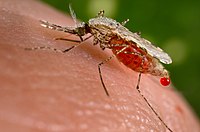Vector (epidemiology)

Hey kiddo, have you ever played with toy cars and trucks that you can push around and move in different directions? Well, a vector in epidemiology is kind of like that.
In the world of science and medicine, a vector is an animal or insect that can carry and transmit diseases from one place to another. Some common examples of vectors are mosquitoes, ticks, and fleas.
Just like toy cars can move in different directions, vectors can move around too. When a vector is carrying a disease, it can spread that disease to other animals or even to humans if it comes into contact with them.
For example, let's say a mosquito carries the Zika virus. If it bites a person who doesn't have the virus, it can pass on the virus to that person. Then that person can get sick and potentially spread the virus to others.
So, it's really important to understand how vectors work in order to control the spread of diseases. Scientists and public health officials study vectors to learn how to prevent and treat diseases they may carry.
Remember, vectors are like little trucks and cars that can move around, and it's important to keep them from spreading diseases by taking precautions like wearing bug spray, using mosquito nets, and cleaning up trash that may attract them.
In the world of science and medicine, a vector is an animal or insect that can carry and transmit diseases from one place to another. Some common examples of vectors are mosquitoes, ticks, and fleas.
Just like toy cars can move in different directions, vectors can move around too. When a vector is carrying a disease, it can spread that disease to other animals or even to humans if it comes into contact with them.
For example, let's say a mosquito carries the Zika virus. If it bites a person who doesn't have the virus, it can pass on the virus to that person. Then that person can get sick and potentially spread the virus to others.
So, it's really important to understand how vectors work in order to control the spread of diseases. Scientists and public health officials study vectors to learn how to prevent and treat diseases they may carry.
Remember, vectors are like little trucks and cars that can move around, and it's important to keep them from spreading diseases by taking precautions like wearing bug spray, using mosquito nets, and cleaning up trash that may attract them.
Related topics others have asked about:
